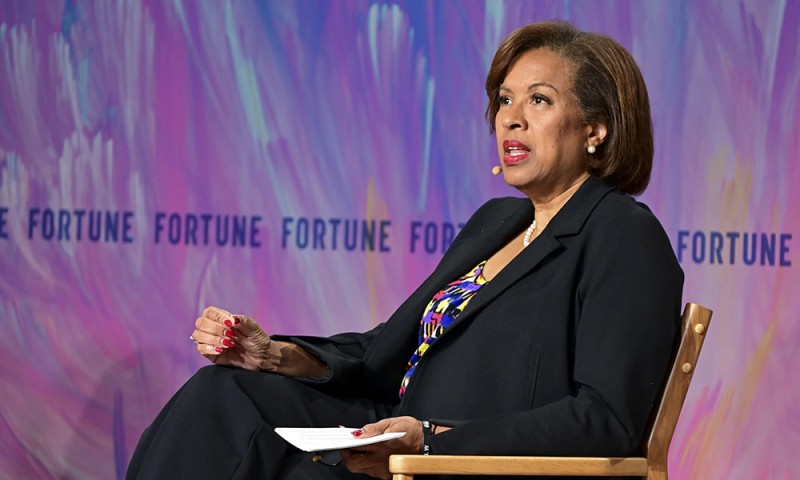
美国一家顶级防务公司的首席执行官表示,对美国国家安全的最大威胁并非技术、对手或资源,而是美国的许多防务战略已经不合时宜。
在《财富》全球最具影响力的商界女性峰会上,科学应用国际公司(SAIC)首席执行官托妮·汤斯-惠特利谈到,这个话题或许显得“书呆子气”和“技术宅”,但战争态势正越来越远离传统冲突战场。她指出:“那些曾经将我们与对手隔开的广阔海洋,如今已不再是我们所熟悉的边界条件。”她强调,美国的对手正在陆、海、空之外的“领域”展开行动,例如网络和太空。她传递的信息是:美国要成功防御此类敌人,还需付出更多努力。
汤斯-惠特利表示,在过去57年里,科学应用国际公司始终致力于将商业技术引入极其复杂的任务环境。她指出,美国的敌人正在以“多种模式”运作,“我认为,在国防领域让我们夜不能寐的一件事,就是我们的对手能够动用其整个工业基础。”
她补充说,美国的情况则不尽相同,其工业基础“随着时间推移已变得不合时宜”,是另一个时代的产物,亦不符合当今时代的需求。她进一步指出,她所理解的工业基础已经“老化”为一种遗留能力。“我们实际上还没有看到足够紧迫的信号,来真正动员我们整个工业基础。”她继续说道,“书呆子气”的答案是,美国可以通过数据将万物互联,从而克服美国不愿像对手那样行动的问题。
紧迫性与现代化
汤斯-惠特利强调,现代化不仅仅是采购最尖端的硬件,而是要重新思考旧政策、整合新技术,并将遗留系统中的精华部分与快速数字创新相结合。汤斯-惠特利在2023年出任首席执行官,成为《财富》美国500强公司的第二位黑人女性CEO。她指出,尽管在数字工程和战场人工智能等领域取得了令人瞩目的进展,但美国的整个防务体系在紧迫性方面仍存在不足。
为说明问题,她引用了一项源自军事领导力的演练:“战时我会这样做吗?”她和团队成员佩戴刻有缩写“WTIW”(Would I do this in war?——“战时我会这样做吗?”)的手环,每天提醒自己要按照真实危机发生时应具备的速度和严肃性行事。虽然国家在面临生存威胁时能够展现出惊人的动员能力,但在和平时期,尤其是在对手以难以捉摸和不可预测的方式潜伏时,维持这种能量要困难得多。
汤斯-惠特利呼吁进行文化变革,主张摒弃植根于过去的术语和概念。她表示:“我认为,我们所使用的词汇本身都已经不合时宜。我建议将‘国防工业基础’改为‘国家安全创新生态系统’。”这一变革旨在同时利用小型初创公司和科技巨头的力量,构建即插即用的系统,使任务驱动的创新得以蓬勃发展。
她补充说,互操作性往往是“当前国家安全领域最不吸引人但最重要的词”。随着联盟作战成为常态,整合众多合作伙伴的数据(每个合作伙伴都有不同的平台和保密等级)可能决定战争的成败。她指出,“金穹”(Golden Dome)导弹防御系统和北美防空司令部(NORAD)的行动正是协作的典范——通过模拟集成和数字孪生技术的运用,展现了正确协作所能带来的成效。
切实解决方案,而非空谈
汤斯-惠特利强调,她所在的公司通过融合传统经验与尖端技术,持续为战斗人员提供支持。她指出,科学应用国际公司三分之一的员工是退伍军人,三分之二持有安全许可,这显示了他们与任务现实的深度契合。但成功需要的不仅仅是这些资质。
美国必须建立一个以技术驱动、敏捷统一的生态系统,通过数字工程、情景模拟以及紧急着手解决根源性瓶颈来加速现代化进程,而许多瓶颈属于政策性而非技术性问题。
她总结道:“可以有不同的名称,这并不重要。我所关心的只有竭尽所能支持战斗人员。我们的语言、行动、资源和预算都要为他们提供支持。”(*)
译者:刘进龙
审校:汪皓
美国一家顶级防务公司的首席执行官表示,对美国国家安全的最大威胁并非技术、对手或资源,而是美国的许多防务战略已经不合时宜。
在《财富》全球最具影响力的商界女性峰会上,科学应用国际公司(SAIC)首席执行官托妮·汤斯-惠特利谈到,这个话题或许显得“书呆子气”和“技术宅”,但战争态势正越来越远离传统冲突战场。她指出:“那些曾经将我们与对手隔开的广阔海洋,如今已不再是我们所熟悉的边界条件。”她强调,美国的对手正在陆、海、空之外的“领域”展开行动,例如网络和太空。她传递的信息是:美国要成功防御此类敌人,还需付出更多努力。
汤斯-惠特利表示,在过去57年里,科学应用国际公司始终致力于将商业技术引入极其复杂的任务环境。她指出,美国的敌人正在以“多种模式”运作,“我认为,在国防领域让我们夜不能寐的一件事,就是我们的对手能够动用其整个工业基础。”
她补充说,美国的情况则不尽相同,其工业基础“随着时间推移已变得不合时宜”,是另一个时代的产物,亦不符合当今时代的需求。她进一步指出,她所理解的工业基础已经“老化”为一种遗留能力。“我们实际上还没有看到足够紧迫的信号,来真正动员我们整个工业基础。”她继续说道,“书呆子气”的答案是,美国可以通过数据将万物互联,从而克服美国不愿像对手那样行动的问题。
紧迫性与现代化
汤斯-惠特利强调,现代化不仅仅是采购最尖端的硬件,而是要重新思考旧政策、整合新技术,并将遗留系统中的精华部分与快速数字创新相结合。汤斯-惠特利在2023年出任首席执行官,成为《财富》美国500强公司的第二位黑人女性CEO。她指出,尽管在数字工程和战场人工智能等领域取得了令人瞩目的进展,但美国的整个防务体系在紧迫性方面仍存在不足。
为说明问题,她引用了一项源自军事领导力的演练:“战时我会这样做吗?”她和团队成员佩戴刻有缩写“WTIW”(Would I do this in war?——“战时我会这样做吗?”)的手环,每天提醒自己要按照真实危机发生时应具备的速度和严肃性行事。虽然国家在面临生存威胁时能够展现出惊人的动员能力,但在和平时期,尤其是在对手以难以捉摸和不可预测的方式潜伏时,维持这种能量要困难得多。
汤斯-惠特利呼吁进行文化变革,主张摒弃植根于过去的术语和概念。她表示:“我认为,我们所使用的词汇本身都已经不合时宜。我建议将‘国防工业基础’改为‘国家安全创新生态系统’。”这一变革旨在同时利用小型初创公司和科技巨头的力量,构建即插即用的系统,使任务驱动的创新得以蓬勃发展。
她补充说,互操作性往往是“当前国家安全领域最不吸引人但最重要的词”。随着联盟作战成为常态,整合众多合作伙伴的数据(每个合作伙伴都有不同的平台和保密等级)可能决定战争的成败。她指出,“金穹”(Golden Dome)导弹防御系统和北美防空司令部(NORAD)的行动正是协作的典范——通过模拟集成和数字孪生技术的运用,展现了正确协作所能带来的成效。
切实解决方案,而非空谈
汤斯-惠特利强调,她所在的公司通过融合传统经验与尖端技术,持续为战斗人员提供支持。她指出,科学应用国际公司三分之一的员工是退伍军人,三分之二持有安全许可,这显示了他们与任务现实的深度契合。但成功需要的不仅仅是这些资质。
美国必须建立一个以技术驱动、敏捷统一的生态系统,通过数字工程、情景模拟以及紧急着手解决根源性瓶颈来加速现代化进程,而许多瓶颈属于政策性而非技术性问题。
她总结道:“可以有不同的名称,这并不重要。我所关心的只有竭尽所能支持战斗人员。我们的语言、行动、资源和预算都要为他们提供支持。”(*)
译者:刘进龙
审校:汪皓
One of America’s top defense CEOs says the biggest threat to national security isn’t technology, adversaries, or resources—it’s the fact that much of U.S. defense strategy has become anachronistic.
Speaking at the Fortune Most Powerful Women Summit, SAIC chief executive Toni Townes-Whitley talked about how it may be “nerdy” and “geeky,” but the world of warfare is increasingly less and less about conventional theaters of conflict. “Those areas where we had large seas or oceans between us and adversaries are no longer the boundary conditions that we have experienced,” she said, noting that the U.S. has adversaries that operate in “domains” beyond land, sea, and air, such as cyber and space. She had a message: The U.S. has more work to do to successfully defend against enemies like this.
For 57 years, Townes-Whitley said, SAIC has been at the “intersection” of commercial technology that is introduced to very complex mission environments. She said she sees that America’s enemies are operating in “multiple modes … I think one of the things that probably keeps us up at night in the national defense world is the fact that our adversary can use their entire industrial base.”
That is not quite the case in the U.S., she added, with an industrial base that has grown “anachronistic over time,” using a word that refers to something that belongs to another period than the present day. She added that what she considers the industrial base has “aged” into a situation of legacy capability. “We haven’t really seen the urgency of the signal yet that we need to in fact enlist all of our industrial base.” The nerdy, geeky answer, she continued, is that you can overcome America’s refusal to act like its adversary by connecting everything together with data.
Urgency and modernization
Modernization isn’t just about buying cutting-edge hardware, said the SAIC CEO, who became just the second Black female CEO in the Fortune 500 when she ascended to the top job in 2023. It’s about rethinking old policies, integrating new technologies, and merging the best of legacy systems with rapid digital innovation. The CEO pointed out that, despite impressive advancements in areas like digital engineering and AI for the battlefield, the underlying system struggles with urgency.
To illustrate the problem, the CEO described an exercise adopted from military leadership: “Would I do this in war?” They and their team wear bracelets inscribed with the acronym WTIW—“Would I do this in war?”—as a daily reminder to act with the speed and seriousness required in a true crisis. While the nation can mobilize impressively in moments of existential threat, sustaining that energy in peacetime—with adversaries lurking in ambiguous, unpredictable ways—is much harder.
The executive urged a cultural shift, advocating for a move away from terms and concepts rooted in the past. “I would argue that the words that we use are even anachronistic. Defense industrial base I would suggest is transitioning to a national security innovation ecosystem,” she said. This shift is about harnessing garage startups and tech giants alike, building plug-and-play systems that allow mission-driven innovation to flourish.
Interoperability, she added, is often “the least sexy word right now in national security, but the most important.” As coalition warfare becomes the norm, integrating data across multiple partners—each with distinct platforms and classification levels—can mean the difference between success and failure. She pointed to the Golden Dome missile defense system and NORAD operations as examples where simulated integration and digital twins demonstrate how collaboration can be effective when done correctly.
Real solutions, not just rhetoric
The CEO emphasized her company’s ongoing role in supporting the war fighter by merging legacy experience with bleeding-edge technology. A third of SAIC’s workforce are veterans, she noted, and two-thirds hold security clearances—a sign of their deep engagement with mission realities. But success demands more than credentials.
The country must develop an ecosystem that’s agile, tech-driven, and unified, with modernization efforts accelerated by digital engineering, scenario simulation, and an urgent focus on root-cause bottlenecks, many of which are policy-based rather than technological.
“The name, we can go left or right on the name. My whole focus is to support the war fighter in all that we do. Our language, our actions, our resources, our budget support the war fighter,” the CEO concluded.

